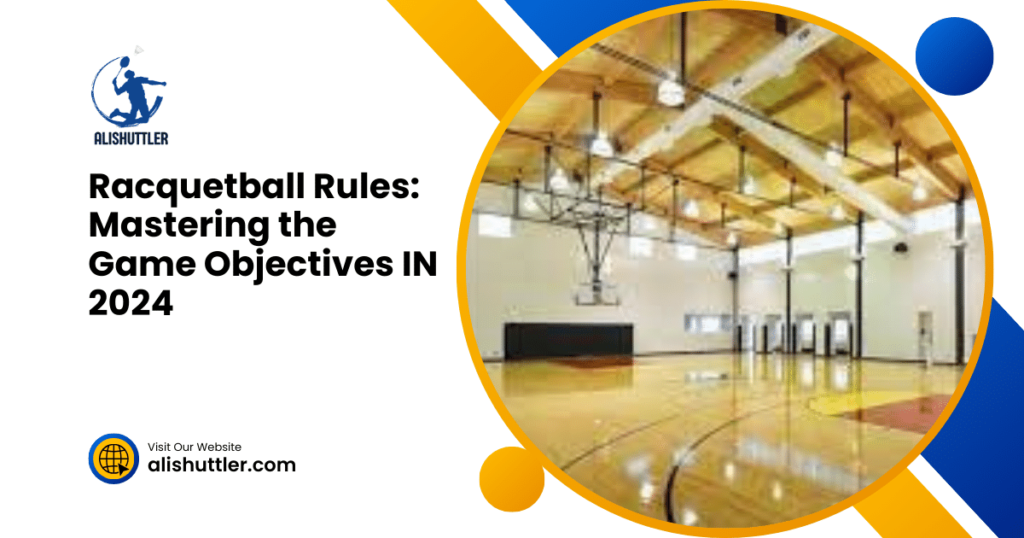Did you know that racquetball rules, including tiebreakers and serves, can vary significantly depending on where you play? Understanding the nuances of these regulations is key to mastering the game and enjoying it to the fullest. Whether you’re a beginner looking to grasp the basics or a seasoned player aiming to fine-tune your skills, having a solid grasp of racquetball rules is essential for success on the court.
Key Takeaways
- Know the Rules: Understanding the basic gameplay rules, scoring dynamics, and game variations is crucial for a successful racquetball game.
- Gear Up Properly: Ensure players have the appropriate gear and equipment to enjoy the game safely and effectively.
- Focus on Scoring: Pay attention to the scoring dynamics to track points accurately and determine the winner correctly.
- Strive for Victory: Aim to win the game by following the rules, utilizing strategies, and outplaying your opponent within the court layout.
- Explore Variations: Experiment with different game variations to keep the gameplay exciting and challenging.
- Practice Court Etiquette: Familiarize yourself with the court layout and adhere to the rules to maintain a fair and enjoyable gaming environment.
Understanding the Game
Basic Objective
Racquetball revolves around outscoring your opponent by hitting the ball within the court boundaries. The primary aim is to reach a predetermined score before your opponent does.
Mastering the basic objective is crucial, as it sets the foundation for strategic gameplay. By understanding this, players can strategize their moves effectively to gain an edge over their opponents.
Gameplay Dynamics
To win points in racquetball, players must serve the ball to start each rally. The server aims to hit the front wall first, above the service line and then below the out line, ensuring that it bounces off once before reaching the ground.
Players alternate hitting the ball until one fails to return it legally or hits a shot that results in a fault. This fault could be due to various reasons, like hitting the ball out of bounds or failing to reach it before its second bounce.
Rules and Regulations
Familiarizing yourself with the rules and regulations of racquetball is essential for fair play and smooth gameplay. These rules cover aspects such as serving, scoring, hindering calls, and court dimensions.
Knowing these regulations helps maintain order during matches and ensures that all players abide by a standardized set of guidelines and rules. It also promotes sportsmanship, fairness, and rule among competitors on the court.
- Pros:
- Clear guidelines ensure fair play.
- Understanding rules enhances gameplay experience.
- Cons:
- Strict adherence may lead to disputes.
- Complex rules can be challenging for beginners.
Players and Gear
Essential Equipment
To play racquetball, players need specific gear. This includes a racquet, balls, and eye protection. The racquet is used to hit the ball against the front wall.
Proper eye protection is crucial in racquetball to prevent injuries from fast-moving balls. Without it, players risk serious eye damage during matches.
Roles in Matches
In singles matches, each player competes individually against their opponent. Doubles matches involve two players on each team working together to win points.
Understanding the roles of each player in both singles and doubles matches is essential for success on the court. Communication and teamwork are key in doubles games.
Footwear and Clothing
Having the right footwear is vital in racquetball. Proper shoes provide stability and support during quick movements around the court.
Wearing appropriate clothing is also important, as it allows players to move freely without any restrictions. Comfortable attire can enhance performance during intense rallies.
Basic Gameplay Rules
Serve
In racquetball, the serve initiates each point and must be hit from within the service zone, according to the rule. The server aims to hit the front wall first, ensuring the ball then reaches beyond the short line.
The serving player’s primary goal is to execute a successful serve, leading to a rally where both players alternate hitting the ball. Only the serving player can score points during a rally by winning it.
Scoring and Winning Points
To earn a point in racquetball, a player must win a rally according to the rule. This means that only the player who served initially can score during that specific rally. The game continues until one player reaches the predetermined score limit.

Players strive to outmaneuver their opponents by strategically placing shots around the court, aiming to make it difficult for their rival to return the ball effectively.
Front Wall Rule
A fundamental rule in racquetball is that the ball must hit the front wall before bouncing twice on the floor. This rule ensures fair play and challenges players to control their shots accurately.
Maintaining control over shot placement is crucial in racquetball, as players strategically aim for angles that make it challenging for their opponent to return shots effectively.
Scoring Dynamics
Game Points
In racquetball, games are commonly played to 15 points. Each rally results in a point being awarded to the serving side if they win the rally. The receiving side can only score when they serve and win the rally.
Tie-Breaker Format
During a tie in racquetball, a tie-breaker format is employed, with games played to 11 points instead of 15. This shortened format adds intensity and excitement to the final stages of a match.
Score Tracking
Players or teams can only score points when they are serving. A player must serve until they lose a rally, at which point the opponent becomes the server. Keeping track of scores accurately is crucial to determining the winner of each game.
Winning the Game
Aim for Victory
To win a game of racquetball, players must reach the agreed-upon number of points first. Typically, matches are played to 15 points in amateur games and 11 points in professional settings.
Strategizing is crucial to securing victory. By focusing on consistency and precision in your shots, you can outplay your opponent. It’s not just about hitting hard but also about placing the ball strategically to make it difficult for your opponent to return.
Importance of Tiebreakers
In intense matches where players are tied at a certain score, a tiebreaker comes into play. The player who wins the tiebreaker wins the match. Tiebreakers are usually played to 1 point or 2 points above the regular winning score, ensuring a clear result.
- Pros:
- Provides an exciting conclusion to closely contested games.
- Rewards players who can maintain their composure under pressure.
- Cons:
- Introduces additional pressure on players.
- Can lead to unexpected outcomes due to the sudden-death nature of tiebreakers.
Mastering Rallies
Rallies are essential in racquetball as they determine which player gains or loses a point. A rally starts with one player serving the ball and continues until one player fails to return it properly. Players must be quick on their feet, anticipating their opponent’s moves and reacting swiftly.

In each rally, both players aim to control the pace and direction of the game. By dominating rallies through skillful shot placement and efficient movement, players can gain an upper hand and accumulate points consistently.
Game Variations
Singles Matches
In singles matches, each player competes individually against their opponent. The game involves intense movement and quick shots to outmaneuver the other player. Players need to exhibit excellent ball control and precise shots to dominate the match.
Doubles Matches
Doubles matches add a unique dynamic as two players team up against another pair. Communication and coordination are crucial in doubles, requiring players to strategize and cover different areas of the court effectively. The game’s pace may vary, with longer rallies and strategic plays.
Cutthroat Matches
In a cutthroat match, three players compete against each other simultaneously. This format adds an element of unpredictability as players must balance offensive and defensive play against two opponents. It demands quick decision-making and adaptability to handle multiple opponents at once.
Players can choose the game variation that best suits their preferences and playing style. Whether you prefer the intensity of singles, the teamwork of doubles, or the challenge of cutthroat, each format offers a unique experience on the racquetball court.
Court Layout
Key Lines
In racquetball, the court layout is defined by various key lines that play crucial roles in gameplay. These include the service line, short line, and receiving line. The service line marks the area behind which a player must stand to serve the ball correctly.
Understanding the importance of these lines is essential for players, as they dictate specific rules and strategies during matches. For instance, crossing the short line before the ball bounces twice results in a fault, giving your opponent a point.
Court Areas
Different court areas serve distinct purposes during a racquetball game. The front wall, side walls, and back wall are all integral parts of the court layout. The front wall is where players aim to hit the ball to make it difficult for their opponents to return shots effectively.
Players strategically use the side walls to execute shots that create challenging angles for their opponents. These walls add an element of skill and precision to gameplay, requiring players to master control and accuracy.
Service Boxes
In doubles matches, players utilize designated service boxes when serving. These boxes are divided into sections on each side of the court, allowing both team members to take turns serving from their respective areas. Serving from the correct box is crucial for maintaining fairness and following established rules.
- Pros:
- Clear delineation of court boundaries enhances gameplay understanding.
- Utilizing different court areas adds depth and complexity to strategies.
- Cons:
- Failure to adhere to specific lines can result in faults or penalties.
Summary of Key Rules
Scoring
In racquetball, scoring is based on a best-of-three or best-of-five games format. Each game is played to 15 points, with a player needing to win by at least one point.

The serving player scores points when they win a rally, while the receiving player has the opportunity to score only when serving.
Gameplay Dynamics
During a match, players must serve from within the service zone and hit the front wall first. The ball can then bounce off any number of walls before being returned.
Players have three opportunities to return the ball after each serve. Failure to do so results in a point for the opponent.
Court Layout Details
Racquetball courts are typically enclosed spaces with four walls, a ceiling, and a floor. The standard court dimensions are 20 feet wide, 40 feet long, and 20 feet high.
The court is divided into specific areas, such as the service box, which is where serves must be made, and the receiving line, which designates where players must stand during serves.
- The service box is the pivotal area for initiating each rally.
- The short line: marks halfway between the back and front walls.
- The safety zone: ensures players have enough space to move freely without obstruction.
Final Remarks on Racquetball Rules
Now that you’ve grasped the ins and outs of racquetball rules, you’re well-equipped to step onto the court with confidence. Understanding the game, familiarizing yourself with players and gear, mastering basic gameplay rules, scoring dynamics, and winning strategies are all vital components to excelling in this fast-paced sport. By exploring game variations and court layouts, you’ve expanded your knowledge base to adapt to different playing scenarios effectively.
Take this newfound knowledge and hit the court! Apply these rules, tactics, and strategies to enhance your racquetball experience. Practice makes perfect, so keep honing your skills and challenging yourself. Whether you’re a beginner or a seasoned player, remember that understanding the rules is your gateway to enjoying the game to its fullest potential.
Frequently Asked Questions
What are the basic gameplay rules of racquetball?
Racquetball is played with a racquet and a hollow rubber ball on an indoor court. The game involves serving the ball to start play, allowing one bounce before returning it, and scoring points if your opponent fails to return the ball legally.
Can you explain the scoring dynamics in racquetball?
In racquetball, games are typically played to 15, 11, or 21 points. Points can only be scored by the serving side. If the serving side wins a rally, they score a point and continue to serve; if the receiving side wins a rally, they earn the serve but do not score.
How can someone win a game of racquetball?
To win a game of racquetball, a player or team must reach the designated number of points first. Common winning point thresholds are 15, 11, or 21 points, depending on the agreed-upon format. A player must also win by at least two points.
What variations exist in playing racquetball games?
Variations in playing racquetball games include singles (one player per side) and doubles (two players per side) matches. There are different formats for scoring, such as straight scoring (every rally counts) or rally scoring (points can be won regardless of serving).
How is the court layout structured in racquetball?
A standard racquetball court is rectangular, with dimensions of 20 feet wide, 40 feet long, and 20 feet high. The front wall features specific lines demarcating zones like service boxes and receiving areas. Understanding these markings is crucial for gameplay strategy and adherence to rules.



